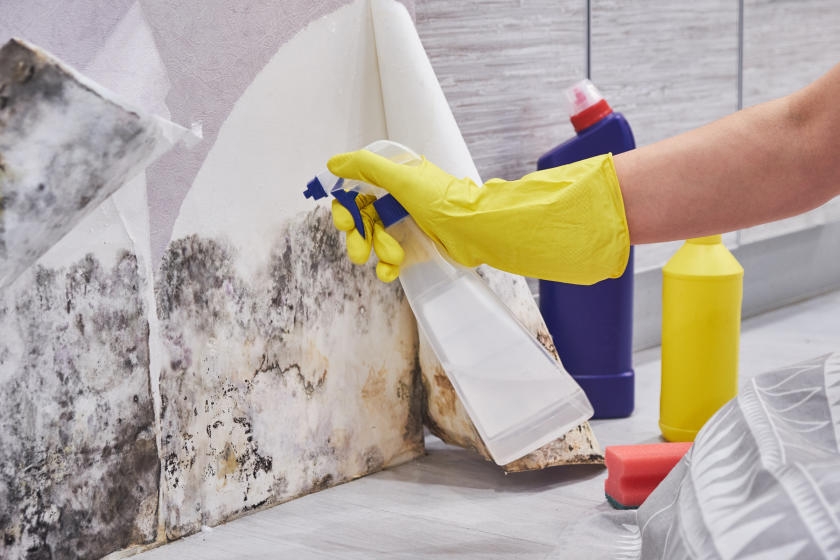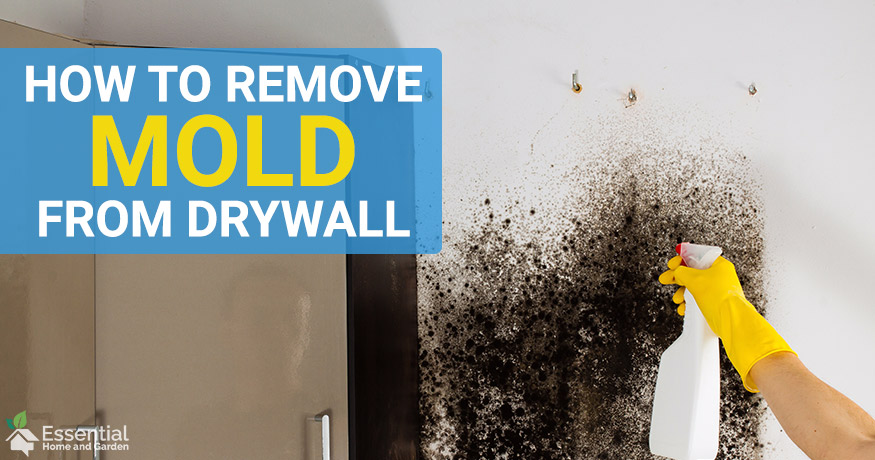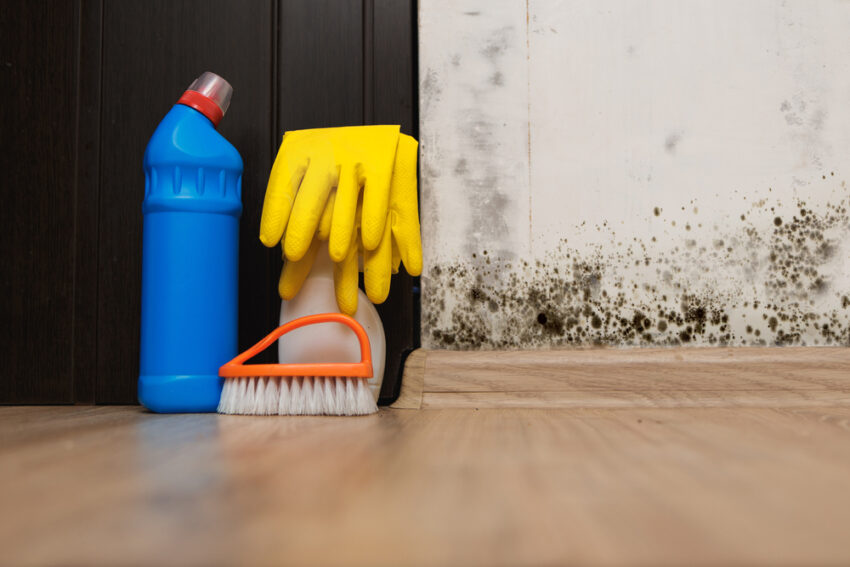If you’ve ever found black mold lurking on your drywall, you might be wondering if your trusty household cleaners can do the trick to eliminate it. With the potential health hazards that black mold poses, it’s essential to address the issue promptly and effectively. In this article, we’ll explore whether using household cleaners can effectively remove black mold from drywall and provide insightful guidance on what you should do if you encounter this stubborn fungus. So let’s dive in and discover the best approach for getting rid of black mold.

Common Types of Household Cleaners
When it comes to household cleaners, there are several common types that many people rely on for their cleaning needs. These cleaners are readily available, cost-effective, and can be effective in tackling various cleaning tasks. In this article, we will discuss some of the common types of household cleaners that can be used to tackle black mold on drywall.
Bleach
Bleach is a popular cleaner that is known for its disinfecting properties. It is highly effective in killing mold and preventing its growth. When using bleach, it is important to dilute it with water according to the manufacturer’s instructions. This will ensure that the bleach is not too strong and will prevent damage to the surfaces being cleaned. Bleach should be applied to the affected area and left to sit for a few minutes before scrubbing and rinsing thoroughly.
Vinegar
Vinegar is another household cleaner that can be used to remove black mold from drywall. It is a natural and non-toxic cleaner that is safe to use around children and pets. Vinegar has acidic properties that help to kill mold and prevent its regrowth. To use vinegar for mold removal, simply pour undiluted vinegar into a spray bottle and spray it onto the affected area. Allow the vinegar to sit for a few minutes before wiping it away with a damp cloth.
Hydrogen Peroxide
Hydrogen peroxide is a powerful oxidizer that can be used to kill black mold on drywall. It is an effective cleaner that can penetrate porous surfaces, making it ideal for tackling mold growth. To use hydrogen peroxide, simply pour it into a spray bottle and spray it onto the affected area. Allow the hydrogen peroxide to sit for about 10 minutes before scrubbing and rinsing thoroughly.
Ammonia
Ammonia is a strong cleaner that can be used to remove black mold from drywall. However, it is important to note that ammonia should never be mixed with bleach or any other household cleaners, as this can create a toxic gas. When using ammonia, it should be diluted with water according to the manufacturer’s instructions. Apply the diluted ammonia solution to the moldy area and leave it for a few minutes before scrubbing and rinsing thoroughly.
Baking Soda
Baking soda is a versatile cleaner that can be used in many different ways, including removing black mold from drywall. It is a natural cleaner that is gentle on surfaces but still effective in killing mold. To use baking soda, simply mix it with water to form a paste. Apply the paste to the moldy area and scrub gently with a brush. Allow the baking soda paste to sit for a few minutes before rinsing it away with water.
Understanding Black Mold on Drywall
Before we discuss the effectiveness of household cleaners on black mold, it is important to have a basic understanding of what black mold is and the potential health risks associated with it.
What is Black Mold?
Black mold, also known as Stachybotrys chartarum, is a type of toxic mold that can grow on various surfaces, including drywall. It thrives in damp and humid environments and can often be found in areas that have experienced water damage or excessive moisture. Black mold is typically characterized by its dark green or black color and a slimy texture. It releases spores into the air, which can cause respiratory issues when inhaled.
Health Risks of Black Mold
Exposure to black mold can pose serious health risks. The spores released by black mold can irritate the respiratory system, leading to symptoms such as coughing, sneezing, and wheezing. Prolonged exposure to black mold can also result in more severe health issues, including allergies, asthma, and even respiratory infections. Individuals with weakened immune systems or pre-existing respiratory conditions are particularly susceptible to the negative effects of black mold.
Identifying Black Mold on Drywall
Identifying black mold on drywall is relatively straightforward, as it is often visible to the naked eye. Look out for dark green or black patches on the walls, especially in areas where there is moisture or water damage. Black mold can also have a distinct musty odor, so pay attention to any strange smells in your home. If you suspect that you have black mold on your drywall, it is important to take action promptly to prevent further growth and protect your health.
Effectiveness of Household Cleaners on Black Mold
Now that we understand the basics of black mold and its potential risks, let’s discuss the effectiveness of common household cleaners in removing black mold from drywall.
Bleach vs. Black Mold
Bleach is often considered one of the most effective cleaners for killing black mold. The active ingredient in bleach, sodium hypochlorite, has strong disinfecting properties that can eliminate mold and inhibit its regrowth. When using bleach, it is crucial to dilute it properly and ensure proper ventilation in the area being cleaned. It is also important to note that bleach may not be suitable for all surfaces, so always test it on a small, inconspicuous area first.
Vinegar vs. Black Mold
Vinegar is a natural and non-toxic cleaner that can also be effective in removing black mold from drywall. The acetic acid in vinegar has antimicrobial properties that can kill mold and prevent its growth. Simply spray undiluted vinegar onto the affected area and let it sit for a few minutes before wiping it away. Vinegar is a safer alternative to harsh chemicals, but it may not be as effective on stubborn or extensive mold growth.
Hydrogen Peroxide vs. Black Mold
Hydrogen peroxide is another effective cleaner that can be used to remove black mold from drywall. It has the ability to penetrate porous surfaces, making it suitable for tackling mold growth on drywall. Simply spray hydrogen peroxide onto the moldy area and let it sit for about 10 minutes before scrubbing and rinsing thoroughly. Hydrogen peroxide is a safe and non-toxic option, but it may not be as powerful as bleach in eliminating stubborn or extensive mold infestations.
Ammonia vs. Black Mold
Ammonia is a strong cleaner that can be used to kill black mold on drywall. However, it is important to exercise caution when using ammonia, as it can be toxic if not used properly. Never mix ammonia with bleach or any other household cleaners, as this can produce a dangerous gas. Dilute the ammonia with water according to the manufacturer’s instructions and apply it to the moldy area. Allow it to sit for a few minutes before scrubbing and rinsing thoroughly.
Baking Soda vs. Black Mold
Baking soda is a versatile cleaner that can be used effectively in removing black mold from drywall. It is a natural and gentle cleaner that is safe to use around children and pets. To use baking soda, mix it with water to form a paste. Apply the paste to the moldy area and scrub gently with a brush. Allow the baking soda paste to sit for a few minutes before rinsing it away with water. Baking soda may not be as potent as bleach or ammonia, but it is a safer and more eco-friendly option.
Safety Precautions and Protection Measures
When dealing with black mold and using household cleaners, it is important to take certain safety precautions to protect yourself and your home.
Wearing Protective Gear
Before attempting to remove black mold, it is essential to wear appropriate protective gear. This can include gloves, goggles, and a mask to prevent inhalation of mold spores and exposure to cleaning chemicals. Make sure to choose gloves that are resistant to mold and chemicals to minimize the risk of skin irritation or chemical burns.
Proper Ventilation
When using household cleaners, ensure proper ventilation in the area being cleaned. Open windows and doors, or use fans to circulate fresh air and dissipate any fumes or odors. This will help minimize your exposure to cleaning chemicals and improve air quality in your home.
Avoiding Mixing Household Cleaners
It is crucial to never mix household cleaners together, as this can produce toxic fumes that can be harmful to your health. Always follow the manufacturer’s instructions and use cleaners separately. Mixing bleach with ammonia, for example, can create a poisonous gas called chloramine, which can cause debilitating respiratory issues.
Testing on a Small Area First
Before using any household cleaner on a large area of drywall, it is advisable to test it on a small, inconspicuous area first. This will help ensure that the cleaner does not damage or discolor the drywall. Apply a small amount of the cleaner to the test area and follow the instructions for application. Observe the area for any adverse reactions before proceeding with cleaning the entire affected area.

When to Seek Professional Help
While household cleaners can be effective in removing black mold from drywall, there are certain situations where it is best to seek professional help.
Severe Mold Infestation
If you are dealing with a severe mold infestation or if the affected area is large and difficult to handle on your own, it is recommended to seek the services of a professional mold remediation company. They have the necessary expertise and equipment to safely and effectively remove black mold from drywall, ensuring that it does not return.
Extensive Damage to Drywall
If the black mold has caused significant damage to the drywall, such as extensive rot or decay, it may be necessary to consult a professional contractor for repairs. They can assess the extent of the damage and provide guidance on the best course of action to ensure the structural integrity of your walls.
Health Concerns
If you or your family members are experiencing severe allergic reactions, respiratory issues, or other health concerns that may be related to black mold exposure, it is crucial to seek medical advice. A healthcare professional can evaluate your symptoms and provide appropriate treatment or refer you to a specialist if necessary.
Lack of Experience or Expertise
If you are unsure about how to safely and effectively remove black mold from drywall, or if you do not have prior experience in mold remediation, it is best to leave the job to professionals. Mold remediation specialists have the necessary training and know-how to handle black mold safely, preventing cross-contamination and minimizing health risks.
Steps to Remove Black Mold from Drywall with Household Cleaners
If you decide to tackle black mold on your own, here are the steps to follow using household cleaners:
Preparation
Before you begin the cleaning process, make sure to prepare the area properly. Remove any furniture or belongings from the vicinity of the moldy area and cover nearby surfaces with plastic sheets or tarps to protect them from cleaning solutions.
Mixing the Cleaning Solution
Prepare the cleaning solution according to the instructions provided by the manufacturer. Whether you are using bleach, vinegar, hydrogen peroxide, ammonia, or baking soda, ensure that you follow the recommended dilution ratios and safety guidelines.
Applying the Cleaner
Once the cleaning solution is prepared, apply it to the moldy area using a spray bottle or a brush. Make sure to cover all affected areas thoroughly, ensuring that the cleaner gets into crevices and cracks where mold may be hidden.
Scrubbing and Agitating
After applying the cleaner, use a brush or sponge to scrub the moldy area gently. This will help loosen and remove the mold from the drywall. Be careful not to apply excessive pressure or scrub too vigorously, as this can damage the drywall surface.
Rinsing and Drying
Once the mold has been scrubbed away, rinse the area thoroughly with clean water. This will remove any residual cleaner and mold spores. After rinsing, allow the drywall to dry completely. Use fans or dehumidifiers to promote airflow and expedite the drying process.

Alternative Methods for Removing Black Mold from Drywall
While household cleaners can be effective in removing black mold, there are alternative methods you can consider:
Natural Remedies
There are several natural remedies that can be used to remove black mold from drywall. These include tea tree oil, grapefruit seed extract, and essential oils like lavender or eucalyptus. These natural alternatives can be mixed with water and applied to the moldy area using a spray bottle or a cloth.
Commercial Mold Removers
There are numerous commercial mold removers available in the market that are specifically designed to effectively remove black mold from drywall. These products often contain powerful cleaning agents and should be used according to the instructions provided by the manufacturer. Always choose a reputable and certified mold remover for the best results.
Preventing Black Mold Growth on Drywall
Prevention is always better than cure when it comes to black mold. Here are a few measures you can take to prevent black mold growth on drywall:
Managing Moisture Levels
Since mold thrives in damp and humid environments, it is important to control moisture levels in your home. Use dehumidifiers in areas that are prone to excess moisture, such as basements or bathrooms. Ensure that there are no leaks or water seepage from pipes, roofs, or windows and promptly address any water damage.
Proper Ventilation
Proper ventilation is key in preventing mold growth. Open windows or use exhaust fans when cooking, showering, or doing laundry to vent excess moisture. This will help keep the air circulating and reduce humidity levels, making it less favorable for mold growth.
Regular Cleaning and Inspection
Regularly clean and inspect areas that are susceptible to mold growth, such as bathrooms, kitchens, and basements. Remove any visible mold promptly and address any signs of water damage or leaks. Regular cleaning and maintenance will help prevent mold from taking hold and spreading.
Repairing Leaks or Water Damage
If you notice any leaks, water stains, or water damage on your drywall, address them promptly. Repair any leaks or plumbing issues, and ensure that the affected area is dried thoroughly. This will prevent the growth of mold and protect the integrity of your drywall.

Conclusion
In conclusion, household cleaners can be effective in removing black mold from drywall. Bleach, vinegar, hydrogen peroxide, ammonia, and baking soda are all viable options for tackling mold growth. However, it is important to take appropriate safety precautions, such as wearing protective gear and proper ventilation, to protect yourself during the cleaning process. In some cases, it may be necessary to seek professional help, especially for severe mold infestations, extensive damage to drywall, or health concerns. By following proper cleaning procedures and implementing preventive measures, you can maintain a mold-free environment and protect the health of your home and family.